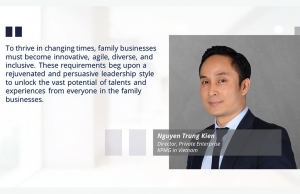Averting family business shift pitfalls
 |
| Johnathan Ooi, leader, Entrepreneurial & Private Business, PwC Vietnam and La Tran Minh, senior manager, Workforce Transformation, PwC Vietnam |
One of the significant challenges in the transition process is the divergence in ideologies, values, and capabilities among generations. In family businesses, success is often intertwined with the legacy and reputation of the founder, who played a dual role as both owner and manager during the establishment and development of the enterprise.
Nevertheless, in the context of numerous changes and fluctuations in the economic and social environment, predecessors need to comprehend the capabilities, personal values, and harmonise the values and abilities of the succeeding generation.
The generational transition is a nuanced process, demanding active participation from both the current and future generations. It necessitates a mindset of respect and proactive communication, fostering an environment that empowers the next generation to assert their unique values and capabilities.
Changing management plays a crucial role in the success of generational transitions. Alongside adequately preparing both in terms of capabilities and mindset for the incumbent and successor before the generational shift, effective change management also contributes to ensuring a successful transition and minimising undesired impacts or risks to the business.
The management of change during generational transitions involves a series of continuous interactive activities among the involved parties – from the incumbent and successor to other family members and other stakeholders of the business. Similar to any other transformational project, generational transitions also require appropriate change management to ensure organisational cohesion and minimise disruptions at the lowest possible level.
Two key factors with the potential to significantly impact the transition process are changes in the corporate culture and the trust of the management team in the new leader. Firstly, changes in culture can stimulate other changes or lead to a sense of uncertainty and resistance to change. Secondly, a decline in the management team’s trust in the new leader can result in a series of decisions to leave the business.
Effective succession planning is paramount for ensuring a smooth transition, alleviating concerns about potential talent loss or disruptions to business operations. Companies dedicating time to meticulous change management within their succession plans are better equipped to navigate a seamless transition, particularly amid economic uncertainties.
The process of handling change during succession involves a structured four-step approach.
In the initial stage, known as organisational preparation, leadership critically evaluates the nature and direction of the succession plan. This pivotal step necessitates a thorough examination of the successor’s potential impact on the organisation, especially the management team, considering both internal and external pressures associated with leadership changes. Prioritising active listening to employees and addressing their concerns becomes paramount as leadership works towards minimising uncertainties and threats.
Moving forward to the second step, building the implementation plan, the organisation forms a dedicated change management team. This team is entrusted with defining the succession plan and exploring various change options based on insights from the first step. Rigorous scrutiny is applied to each option, evaluating aspects such as clarity, alignment with organisational goals, cultural compatibility, anticipated impact on the current structure, resource alignment, and consistency with the business owner’s personal goals.
The third step, communication and employee engagement, underscores the critical role of communication as a tool to shape the firm’s culture and foster commitment to change. The change management team identifies departments and individuals most affected by the new leader, gaining insights into their emotional responses to change.
Successful implementation of change relies on consistent, timely, and personalised communication of core messages. While conflicts and resistance are inevitable, effective dialogue and consultation in the initial phase can minimise conflict levels. Resolving resistance requires identifying and appropriately handling symptoms and origins.
Lastly, the evaluation stage occurs before businesses assess the generational transition process. The successor requires sufficient time to gain confidence in their new role. The evaluation process identifies emerging issues, such as changes in organisational structure or the need for restructuring the management team. This evaluation marks a continuous cycle, with each successfully implemented change serving as motivation for the subsequent one.
 | Family businesses: Continuing the future of a legacy KPMG Enterprise, in collaboration with the STEP Project Global Consortium, has conducted an in-depth global survey of nearly 2,500 family business leaders. Following that, a series of roundtable discussions with family business CEOs, academics, and advisers were carried out in February, before the survey report was released in May. |
 | Family governance of utmost priority for business success Family business owners in Vietnam are being confronted with formidable challenges building trust among family members, according to a PwC conference last week, focused on fostering trust in family enterprises. |
 | Navigating challenges and embracing succession: Insights for Vietnamese family businesses Vietnam’s family businesses should prioritise the paramount importance of a well-crafted succession plan to secure their long-term success and effectively pass on leadership to future generations. |
What the stars mean:
★ Poor ★ ★ Promising ★★★ Good ★★★★ Very good ★★★★★ Exceptional
Related Contents
Latest News
More News
- Pivotal stage of growth paves way for rise in M&As (December 03, 2025 | 10:00)
- Positive projections for M&A interest from Thailand (December 03, 2025 | 09:40)
- Manifesting the first line of defence in cybersecurity (December 03, 2025 | 09:00)
- The transformational role AI can play in accounting arena (December 03, 2025 | 08:00)
- Unlocking 5G-AI potential in Singapore (December 03, 2025 | 08:00)
- Data-driven strategies vital for a fast-evolving nation (December 02, 2025 | 09:41)
- Policy to practice: how Vietnam can lead the region (November 26, 2025 | 16:03)
- Mobilising private capital at scale vital for climate battle (November 26, 2025 | 15:36)
- VILAF and Yoon & Yang launch Vietnam - Korea Practice Unit (November 26, 2025 | 15:16)
- Trademark disputes challenge foreign firms in Vietnam (November 24, 2025 | 15:30)

 Tag:
Tag:






















 Mobile Version
Mobile Version